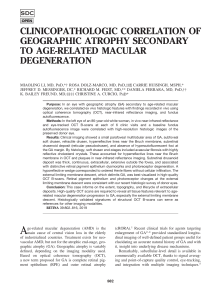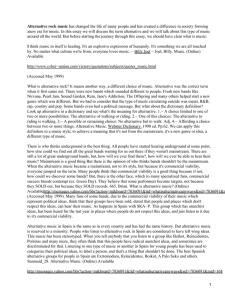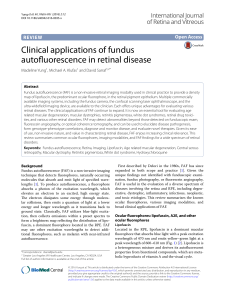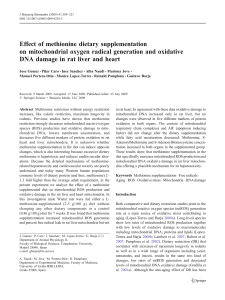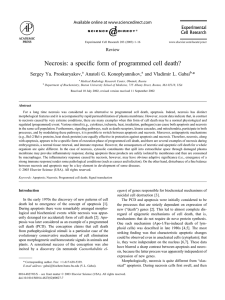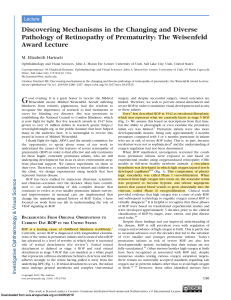Effects of Light-emitting Diode Radiations on Human
Anuncio
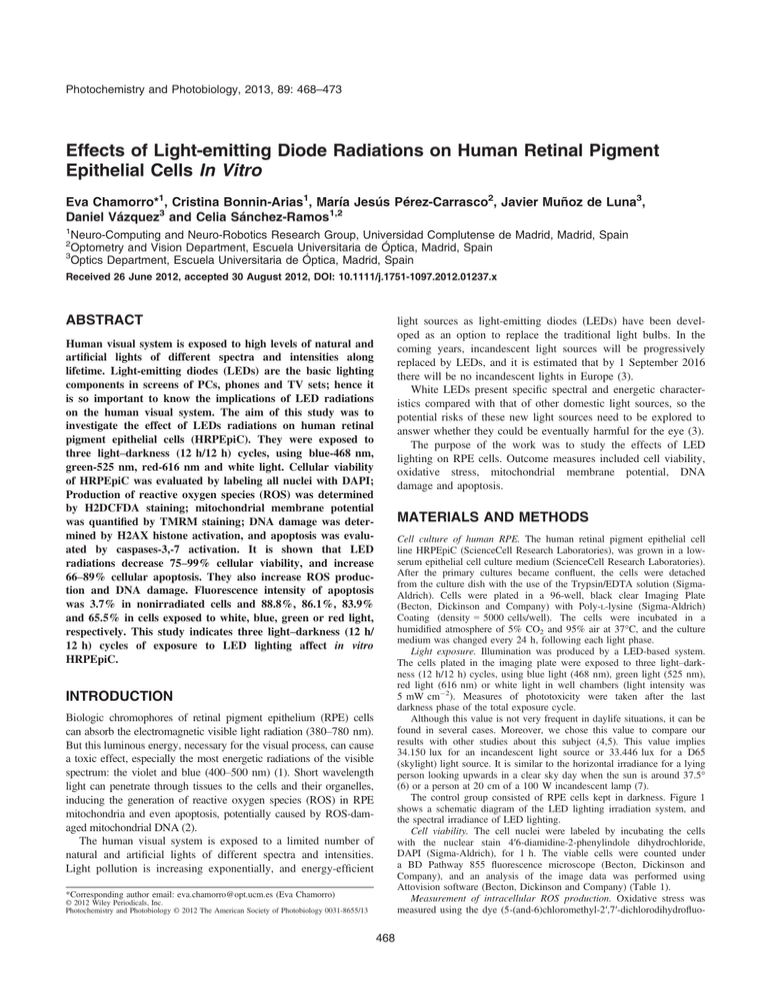
Photochemistry and Photobiology, 2013, 89: 468–473 Effects of Light-emitting Diode Radiations on Human Retinal Pigment Epithelial Cells In Vitro Eva Chamorro*1, Cristina Bonnin-Arias1, María Jesús Pérez-Carrasco2, Javier Muñoz de Luna3, Daniel Vázquez3 and Celia Sánchez-Ramos1,2 1 Neuro-Computing and Neuro-Robotics Research Group, Universidad Complutense de Madrid, Madrid, Spain Optometry and Vision Department, Escuela Universitaria de Óptica, Madrid, Spain 3 Optics Department, Escuela Universitaria de Óptica, Madrid, Spain 2 Received 26 June 2012, accepted 30 August 2012, DOI: 10.1111/j.1751-1097.2012.01237.x ABSTRACT light sources as light-emitting diodes (LEDs) have been developed as an option to replace the traditional light bulbs. In the coming years, incandescent light sources will be progressively replaced by LEDs, and it is estimated that by 1 September 2016 there will be no incandescent lights in Europe (3). White LEDs present specific spectral and energetic characteristics compared with that of other domestic light sources, so the potential risks of these new light sources need to be explored to answer whether they could be eventually harmful for the eye (3). The purpose of the work was to study the effects of LED lighting on RPE cells. Outcome measures included cell viability, oxidative stress, mitochondrial membrane potential, DNA damage and apoptosis. Human visual system is exposed to high levels of natural and artificial lights of different spectra and intensities along lifetime. Light-emitting diodes (LEDs) are the basic lighting components in screens of PCs, phones and TV sets; hence it is so important to know the implications of LED radiations on the human visual system. The aim of this study was to investigate the effect of LEDs radiations on human retinal pigment epithelial cells (HRPEpiC). They were exposed to three light–darkness (12 h/12 h) cycles, using blue-468 nm, green-525 nm, red-616 nm and white light. Cellular viability of HRPEpiC was evaluated by labeling all nuclei with DAPI; Production of reactive oxygen species (ROS) was determined by H2DCFDA staining; mitochondrial membrane potential was quantified by TMRM staining; DNA damage was determined by H2AX histone activation, and apoptosis was evaluated by caspases-3,-7 activation. It is shown that LED radiations decrease 75–99% cellular viability, and increase 66–89% cellular apoptosis. They also increase ROS production and DNA damage. Fluorescence intensity of apoptosis was 3.7% in nonirradiated cells and 88.8%, 86.1%, 83.9% and 65.5% in cells exposed to white, blue, green or red light, respectively. This study indicates three light–darkness (12 h/ 12 h) cycles of exposure to LED lighting affect in vitro HRPEpiC. MATERIALS AND METHODS Cell culture of human RPE. The human retinal pigment epithelial cell line HRPEpiC (ScienceCell Research Laboratories), was grown in a lowserum epithelial cell culture medium (ScienceCell Research Laboratories). After the primary cultures became confluent, the cells were detached from the culture dish with the use of the Trypsin/EDTA solution (SigmaAldrich). Cells were plated in a 96-well, black clear Imaging Plate (Becton, Dickinson and Company) with Poly-L-lysine (Sigma-Aldrich) Coating (density = 5000 cells/well). The cells were incubated in a humidified atmosphere of 5% CO2 and 95% air at 37°C, and the culture medium was changed every 24 h, following each light phase. Light exposure. Illumination was produced by a LED-based system. The cells plated in the imaging plate were exposed to three light–darkness (12 h/12 h) cycles, using blue light (468 nm), green light (525 nm), red light (616 nm) or white light in well chambers (light intensity was 5 mW cm 2). Measures of phototoxicity were taken after the last darkness phase of the total exposure cycle. Although this value is not very frequent in daylife situations, it can be found in several cases. Moreover, we chose this value to compare our results with other studies about this subject (4,5). This value implies 34.150 lux for an incandescent light source or 33.446 lux for a D65 (skylight) light source. It is similar to the horizontal irradiance for a lying person looking upwards in a clear sky day when the sun is around 37.5° (6) or a person at 20 cm of a 100 W incandescent lamp (7). The control group consisted of RPE cells kept in darkness. Figure 1 shows a schematic diagram of the LED lighting irradiation system, and the spectral irradiance of LED lighting. Cell viability. The cell nuclei were labeled by incubating the cells with the nuclear stain 4′6-diamidine-2-phenylindole dihydrochloride, DAPI (Sigma-Aldrich), for 1 h. The viable cells were counted under a BD Pathway 855 fluorescence microscope (Becton, Dickinson and Company), and an analysis of the image data was performed using Attovision software (Becton, Dickinson and Company) (Table 1). Measurement of intracellular ROS production. Oxidative stress was measured using the dye (5-(and-6)chloromethyl-2′,7′-dichlorodihydrofluo- INTRODUCTION Biologic chromophores of retinal pigment epithelium (RPE) cells can absorb the electromagnetic visible light radiation (380–780 nm). But this luminous energy, necessary for the visual process, can cause a toxic effect, especially the most energetic radiations of the visible spectrum: the violet and blue (400–500 nm) (1). Short wavelength light can penetrate through tissues to the cells and their organelles, inducing the generation of reactive oxygen species (ROS) in RPE mitochondria and even apoptosis, potentially caused by ROS-damaged mitochondrial DNA (2). The human visual system is exposed to a limited number of natural and artificial lights of different spectra and intensities. Light pollution is increasing exponentially, and energy-efficient *Corresponding author email: eva.chamorro@opt.ucm.es (Eva Chamorro) © 2012 Wiley Periodicals, Inc. Photochemistry and Photobiology © 2012 The American Society of Photobiology 0031-8655/13 468 Photochemistry and Photobiology, 2013, 89 rescein diactate acetyl ester H2DCFDA (Invitrogen, Germany) at a final concentration of 1:1000 for 30 min at 37°C in darkness. Excess dye was removed by washing in PBS. Fluorescence intensity was measured in a BD Pathway 855 Bioimager (Becton, Dickinson and Company) using an excitation band pass filter at 492–495 nm and an emission cutoff filter at 517–527 nm. Measurement of mitochondrial membrane potential (MMP). Mitochondrial damage was assessed by using the dye Tetramethylrhodamine, methyl ester, TMRM (Invitrogen) at a final concentration of 1:1000 for 30 min at 37°C in darkness. Excess dye was removed by washing in PBS. Fluorescence intensity was measured in a BD Pathway 855 Bioimager (Becton, Dickinson and Company) using an excitation band pass filter at 549 nm and an emission cutoff filter at 572 nm. Immunocytochemical detection of histone H2AX and activated caspase-3 and -7. DNA damage and apoptosis were evaluated by immunocytochemistry, evaluating the activation of histone H2AX and caspases-3 and -7. At given time periods, cells were washed with phosphate-buffered saline, (PBS; Sigma-Aldrich) and fixed with 4% paraformaldehyde (Sigma-Aldrich) for 1 h. Cells were suspended in 0.3% Triton X-100PBS (Sigma-Aldrich) in a 3% bovine serum albumin (BSA; SigmaAldrich) 1% (wt/vol) in PBS for 30 min to suppress. The cells were then incubated in 2.5% PBS + BSA containing either a combination of 1:400 469 diluted antiphospho-histone H2AX (Abcam, UK) and 1:400 anticaspase-3 rabbit antibody (Cell Signaling Technology). The cells were then incubated for 1 h and washed twice with PBS, and resuspended in 1:400 diluted goat antimouse Alexa Fluor 633 conjugated (Invitrogen) and 1:400 diluted goat antirabbit Alexa Fluor 488 (Invitrogen) for 30 min at room temperature in darkness. After three washing steps, the fluorescence of the samples was measured in the Pathway 855 automated fluorescence microscope (Becton, Dickinson and Company) using an excitation band pass filter at 632 nm and an emission cutoff filter at 647 nm for caspase3, -7 detection. For histone H2AX detection, an excitation band pass filter at 488 nm and an emission cutoff filter at 594 nm were used. Statistical analysis. Every experiment was repeated three times. The values were given as mean ± SD. Data were analyzed using an unpaired two-tailed t-test by Statgraphics version Centurion XVI.I. A P value less than 0.05 was considered statistically significant. RESULTS Cell viability Nonirradiated RPE cells grew properly, but the irradiation inhibited the growth of RPE cells. The difference in the cell number of RPE cells irradiated by blue, green or white LED lighting and nonirradiated was statistically very significant (P < 0.01). Maximum damage was observed in cells exposed to blue LED lighting. In the experiments, 99%, 88% and 75% of the irradiated cells became nonviable after their exposure to blue, green or white light. Red light caused a slight decrease of number of RPE cells. However, the difference in cell number of RPE cells irradiated by red light and not irradiated was statistically insignificant (Figs. 2A, 3A and 4A). Measurement of intracellular ROS production Low level production of reactive oxygen species was observed in RPE cells maintained in darkness. However, a significant increase in the level of ROS was observed after three light–darkness cycles (12 h/12 h) with blue light, green light or red light. Nonincrease of cellular cytoplasm fluorescence was detected in cells exposed to white LED lighting in comparison with non irradiated cells (Figs. 2B, 3B and 4B). Measurement of mitochondrial membrane potential After three light–darkness cycles of irradiation, no significant effect on mitochondrial membrane potential was detectable compared to control cells for any of the different LED lighting (Figs. 2C, 3C and 4C). Effects of light on DNA damage of RPE Figure 1. Schematic diagram of the LED lighting irradiation system and spectral irradiance of the different LED lighting sources: blue, green, red and white light. Significant DNA damage was observed for light-exposed RPE cells. The fluorescence microscopic data for all irradiated RPE Table 1. Cell viability, reactive oxygen species ROS production, mitochondrial membrane potential, DNA damage and apoptosis of cultured RPE irradiated with blue, green, red and white LED lighting. Values indicate fluorescence intensity, mean ± SD. Control Viability (FU) ROS (FU) MMP (FU) DNA damage (FU) Apoptosis (%) 855 593 634 131 3.7 *P < 0.05 compared to the control. ± ± ± ± ± 403 78 19 41 0.02 Blue light 10 737 620 2537 86.1 ± ± ± ± ± 2* 19* 39 589* 0.03* Green light 99 855 823 2258 83.9 ± ± ± ± ± 114* 30* 30 738* 0.05* Red light 339 1004 780 1920 65.5 ± ± ± ± ± 1 49* 128 286* 0.07* White Light 217 656 770 2697 88.8 ± ± ± ± ± 108* 26 18 493* 0.02* 470 Eva Chamorro et al. Figure 2. Representative images of effects of LED lighting on human retinal pigment epithelial cells in vitro. HRPEpiC cells were exposed to blue, green, red and white LED lighting (irradiated cells) or maintained in darkness (control) for three light–darkness cycles (12 h/12 h). (A) Cellular viability of HRPEpic cells determined by labeling all nuclei with DAPI. (B) ROS production determined by the H2DCFDA staining and fluorescence microscopy; an increase of fluorescence in cells indicates oxidative stress. (C) Mitochondrial membrane potential determined by the TMRM staining and fluorescence microscopy. Reduction or absence of fluorescence indicates decrease of MMP. (D) DNA damage determined by the activation of H2AX histone. (E) Apoptosis determined by the activation of caspases-3,-7. The white arrows indicate apoptotic cells. cells show the increased degradation of nucleic acids in comparison with the control cells. Maximum damage was showed to cells exposed to blue LED lighting (Figs. 2D, 3D and 4D). Detection of apoptosis The percentage of apoptotic cells was increased on light-exposed RPE cells in comparison with RPE cells maintained in darkness. The death of nonirradiated RPE cells reached a frequency of 3.7%. However, cell death was 86%, 84%, 66% and 89% for blue, green, red and white-irradiated RPE, respectively (Figs. 2E, 3E and 4E). DISCUSSION Epidemiological studies suggest an association between visible light exposure and increased risk of advanced age-related macular degeneration (AMD). Visible light can affect the retina and RPE by photochemical, thermal and mechanical mechanism (8). Photochemical damage occurs when the incident radiation has a wavelength in the high energy portion of the visible spectrum. An electron in an excited state can return to the inhibited state dissipating the extra energy. One way to dissipate this energy is to break a bond in another molecule through a direct exchange of electron or direct exchange of hydrogen producing reactive oxygen species (ROS) (2,4,9). A proposed mechanism of cell damage induced by light is the oxidative process (10). The outer layers of the retina are continuously exposed to high levels of oxygen due to the abundant blood supply of the choriocapillaries (1,3). The formation of ROS at the level of the RPE leads to cell damage with the subsequent degeneration of photoreceptors (11). Noell (1980) was the first to observe that the action spectrum of retinal damage induced by light was similar to the action spectrum of rhodopsin (scotopic sensitivity), thus suggesting that rhodopsin or its photoproducts were acting as mediators in the retinal damage (8,12). Subsequent studies have supported this mechanism (13,14). Experimental evidence has demonstrated that the retina and RPE are much more sensitive to blue light damage than red or green light (9,15,16). Most research works have been focused on evaluating the response of the retina to light from conventional lighting sources as halogen or fluorescent. It has been speculated that LED lighting radiation may cause ocular damage (3), however, the potential risks of these new light sources has not been explored. In this study, we have demonstrated that LED lighting can damage RPE cells. The results of this study clearly show that LED lighting radiation decreases by 75–99% the cellular viability and increases by 66–89% the cellular apoptosis, as well as there is an increase in the production of ROS and DNA damage. These results are consistent with previous reports that suggest that visible light of conventional light sources could cause Photochemistry and Photobiology, 2013, 89 Figure 3. Effects of monochromatic LED lighting on human retinal pigment epithelial cells in vitro. HRPEpiC cells were exposed to blue, green and red LED lighting (irradiated cells) or maintained in darkness (control) for three light–darkness cycles (12 h/12 h). The graph displays mean fluorescence intensity radios of irradiated cells versus non irradiated controls. Bars represent mean ± SD from n = 3–5 experiments. The asterisk (*) indicates significant differences as compared to controls (P < 0.05, Student’s t-test). (A) Cellular viability of HRPEpic cells determined by labeling all nuclei with DAPI. (B) ROS production determined by the H2DCFDA staining and fluorescence microscopy. (C) Mitochondrial membrane potential determined by the TMRM staining and fluorescence microscopy. (D) DNA damage determined by the activation of H2AX histone. (E) Apoptosis determined by the activation of caspases-3, -7 is observed as a pink coloration around DAPI-stained cells. 471 Figure 4. Effects of white LED lighting on human retinal pigment epithelial cells in vitro. HRPEpiC cells were exposed to white LED lighting (irradiated cells) or maintained in darkness (control) for three light–darkness cycles (12 h/12 h). The graph displays mean fluorescence intensity radios of irradiated cells versus non irradiated controls. Bars represent mean ± SD from n = 3–5 experiments. The asterisk (*) indicates significant differences as compared to controls (P < 0.05, Student’s t-test). (A) Cellular viability of HRPEpic cells determined by labeling all nuclei with DAPI. (B) ROS production determined by the H2DCFDA staining and fluorescence microscopy. (C) Mitochondrial membrane potential determined by the TMRM staining and fluorescence microscopy. (D) DNA damage determined by the activation of H2AX histone. (E) Apoptosis determined by the activation of caspases-3, -7 is observed as a pink coloration around DAPI-stained cells. 472 Eva Chamorro et al. cell damage. Sparrow et al. (5) analyzed human RPE cells irradiated with blue light (430 nm, 8 mW cm 2), green light (550 nm, 8 mW cm 2) and white light (246 mW cm 2). The light was delivered from a tungsten halogen source for 20 min and it was observed that illuminated RPE cells remained viable. In another study, Godley et al. exposed confluent cultures of human primary retinal epithelial cells to visible light (390– 550 nm at 2.8 mW cm 2) of a metal halide lamp for 0–9 h and analyzed cell viability and ROS production. Cells maintained in the absence of blue light exposure showed no decrease in viability, no mitochondrial or nuclear DNA damage and low level production of ROS; however, blue light-irradiated cells showed an increasing loss of viability (ca 10%), timedependent increase in the levels of ROS and maximal mitochondrial DNA damage 3 h after exposure with evidence of some repair mechanism (1). On the other hand, Chu et al. studied changes on viability of RPE as a result of blue and red halogen light irradiation. Early passages of human RPE cells were exposed to blue light (460 nm, 0.4 mW cm 2) and red light (640 nm, 1 mW cm 2) for 48 h. Cell viability was not significantly affected by bluelight irradiation or red-light irradiation at low doses (17). Later on, Youn et al. investigated light-induced retinal damage in human RPE cells exposed to specific narrow wavebands of blue light obtained using interference filters and an arc lamp system (400 nm at an irradiance of 1.555 mW cm 2, 420 nm at an irradiance of 1.466 mW cm 2 and 435.8 nm at an irradiance of 1.351 mW cm 2) for 3–12 h. Cells exposed to 400 nm light showed decrease in cell viability, degradation of mitochondria and nucleic acids damage; however, no alterations were observed for 420 and 435.8 nm light-exposed RPE cells (18). Of relevance is the research carried out by Roehlecke et al. in which they evaluated the in vitro response of RPE cells exposed to blue LED lighting. Cells were irradiated with 405 nm light at an output power of 0.3 or 1 mW cm 2 for 3, 24 or 72 h. The data showed a significantly stimulated ROS production and a decrease of mitochondrial membrane potential after 24 h of exposure to blue light, but no apoptosis or viability changes were evidenced. They used low doses of light for up to 72 h without a repair time, to establish an in vitro model system in which light irradiation induced mild stress without causing cell death (2). It has been suggested that cells may adapt themselves to the light-induced stress and therefore survive (2) so in the present study we have exposed cells to three light–darkness cycles (12 h/12 h) instead of continuous light. It is relevant that ROS production was the highest in cells irradiated with the red light, not correlating with DNA damage or apoptosis where blue and green light produce more phototoxic effects. From this we can infer that ROS are not the only elements responsible for cell damage and apoptosis. Other photosensitive molecules have been studied, mitochondrial respiratory chain enzymes (13,19,20), melanin (21) and products of intermediate intermedia genes (10,11,14). However, our results regarding ROS must be considered with caution since the presence of photosensitizers such as riboflavin in the culture medium can influence on light-dependent ROS generation (22–24). Summing up, three light–darkness cycles (12 h/12 h) exposure to LED lighting affect the growth of RPE cells, produce cellular stress increasing ROS levels accompanying an increase of DNA damage and apoptotic cells. Future investigation will determine the intensities and wavelengths of LED lighting which are lethal and nonlethal for ocular tissues, as well as the effect of optical filters in RPE cell protection. This information will be necessary to develop appropriate normative for this growing industry field. Acknowledgement—This work has been supported in part by Fundación Mapfre (Spain). REFERENCES 1. Godley, B. F., F. A. Shamsi, F. Q. Liang, S. G. Jarrett, S. Davies and M. Boulton (2005) Blue light induces mitochondrial DNA damage and free radical production in epithelial cells. J. Biol. Chem. 280, 21061–21066. 2. Roehlecke, C., A. Schaller, L. Knels and R. H. Funk (2009) The influence of sublethal blue light exposure on human RPE cells. Mol. Vis. 15, 1929–1938. 3. Behar-Cohen, F., C. Martinsons, F. Vienot, G. Zissis, A. BarlierSalsi, J. P. Cesarini, O. Enouf, M. Garcia, S. Picaud and D. Attia (2011) Light-emitting diodes (LED) for domestic lighting: any risks for the eye? Prog. Retin. Eye Res. 30, 239–257. 4. Hui, S., L. Yi and Q. L. Fengling (2009) Effects of light exposure and use of intraocular lens on retinal pigment epithelial cells in vitro. Photochem. Photobiol. 85, 966–969. 5. Sparrow, J. R., A. S. Miller and J. Zhou (2004) Blue light-absorbing intraocular lens and retinal pigment epithelium protection in vitro. J. Cataract Refract. Surg. 30, 873–878. 6. Vazquez, D. and E. Bernabeu (1997) Quantitative estimation of clear sky light in Madrid. Energy Build. 26, 331–336. 7. ORAM (2005) General Light Brochure. OSRAM, Spin. 8. Wu, J., S. Seregard and P. V. Algvere (2006) Photochemical damage of the retina. Surv. Ophthalmol. 51, 461–481. 9. Ham, W. T., H. A. Mueller and D. H. Sliney (1976) Retinal sensitivity to damage from short wavelength light. Nature 260, 153– 155. 10. Wenzel, A., C. Grimm, A. Marti, N. Kueng-Hitz, F. Hafezi, G. Niemeyer and C. E. Reme (2000) c-fos controls the “private pathway” of light-induced apoptosis of retinal photoreceptors. J. Neurosci. 20, 81–88. 11. Grimm, C., A. Wenzel, F. Hafezi and C. E. Reme (2000) Gene expression in the mouse retina: the effect of damaging light. Mol. Vis. 6, 252–260. 12. Noell, W. K. (1980) Possible mechanisms of photoreceptor damage by light in mammalian eyes. Vision. Res. 20, 1163–1171. 13. Pautler, E. L., M. Morita and D. Beezley (1990) Hemoprotein(s) mediate blue light damage in the retinal pigment epithelium. Photochem. Photobiol. 51, 599–605. 14. Reme, C. E. (2005) The dark side of light: rhodopsin and the silent death of vision the proctor lecture. Invest. Ophthalmol. Vis. Sci. 46, 2671–2682. 15. Ham, W. T., H. A. Mueller, J. J. Ruffolo and A. M. Clarke (1979) Sensitivity of the retina to radiation-damage as a function of wavelength. Photochem. Photobiol. 29, 735–743. 16. Dorey, C. K., F. C. Delori and K. Akeo (1990) Growth of cultured RPE and endothelial cells is inhibited by blue light but not green or red light. Curr. Eye Res. 9, 549–559. 17. Chu, R., X. Zheng, D. Chen and D. N. Hu (2006) Blue light irradiation inhibits the production of HGF by human retinal pigment epithelium cells in vitro. Photochem. Photobiol. 82, 1247–1250. 18. Youn, H. Y., B. R. Chou, A. P. Cullen and J. G. Sivak (2009) Effects of 400, 420, and 435.8 nm radiations on cultured human retinal pigment epithelial cells. J. Photochem. Photobiol. B 95, 64–70. 19. Beatty, S., H. Koh, M. Phil, D. Henson and M. Boulton (2000) The role of oxidative stress in the pathogenesis of age-related macular degeneration. Surv. Ophthalmol. 45, 115–134. 20. Suter, M., C. Reme, C. Grimm, A. Wenzel, M. Jaattela, P. Esser, N. Kociok, M. Leist and C. Richter (2000) Age-related macular degeneration. The lipofusion component N-retinyl-N-retinylidene ethanolamine detaches proapoptotic proteins from mitochondria and induces Photochemistry and Photobiology, 2013, 89 apoptosis in mammalian retinal pigment epithelial cells. J. Biol. Chem. 275, 39625–39630. 21. Marshall, J. (1985) Radiation and the ageing eye. Ophthalmic Physiol. Opt. 5, 241–263. 22. Grzelak, A., B. Rychlik and G. Bartosz (2001) Light-dependent generation of reactive oxygen species in cell culture media. Free Radic. Biol. Med. 30, 1418–1425. 473 23. Wang, R. J. (1976) Effect of room fluorescent light on the deterioration of tissue culture medium. In Vitro 12, 19–22. 24. Mahns, A., I. Melchheier, C. V. Suschek, H. Sies and L. O. Klotz (2003) Irradiation of cells with ultraviolet-A (320–400 nm) in the presence of cell culture medium elicits biological effects due to extracellular generation of hydrogen peroxide. Free Radic. Res. 37, 391–397.
